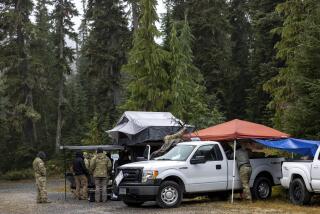Airmen Return to Point Mugu to Cries of Joy After War Duty
- Share via
After months of directing bombing raids over Afghanistan, five E-2C Hawkeye aircraft emerged over Point Mugu Naval Air Station on Thursday to the cheers and cries of the pilots’ families waiting below.
Flying in diamond formation, the special radar-equipped surveillance planes banked steeply before rolling onto the runway at the Navy base.
Moments later, wives and children sprinted to the planes, nearly tackling the 20 airmen as they appeared.
For most, it had been more than six months since they had seen their husbands and fathers. Some quickly made up for lost time.
“Give papa a hug! Give papa a kiss! Tell papa what a cow says!” Lauren Valluzzi Carambas urged her 1-year-old daughter, Madaline.
Farther down the tarmac, Marina Pham toddled over to Lt. Cmdr. Tony Pham.
“I’ve been gone half her life,” Pham said, hoisting his 1-year-old daughter into his arms. “When I last saw her she couldn’t walk.”
Airborne Early Warning Squadron 117 left Point Mugu on July 27 on routine deployment aboard the aircraft carrier Carl Vinson. The carrier was the closest ship to the Persian Gulf on Sept. 11, when the attacks on the World Trade Center and Pentagon occurred.
The squadron was quickly moved to the gulf and the Hawkeyes, the Navy’s newest carrier-based command-and-control aircraft, were among the first planes used in the air war over Afghanistan.
The propeller-driven Hawkeyes, which have a large rotating radar disc on top, flew over Afghanistan and instructed allied fighter and bomber aircraft where to drop their payloads.
“We were like the guys at the football game high up in the coach’s box looking down at the field and directing the plays,” said Lt. Cmdr. Michael Carambas, 35, of Camarillo.
The airmen said they often attracted machine gun and antiaircraft fire but were never hit.
“You had to be flexible, because the game plan changes all the time,” 29-year-old Lt. Frank Perry said. “You might get a target and then have to cancel and go somewhere else.”
Along the way they picked up Al Qaeda transmissions, Carambas said.
The planes flew every day for at least five hours and in November logged 500 hours, said Commanding Officer John C. Oberst, 44, of Camarillo.
“We were doing battle management,” Oberst said. “Every aircraft in the theater would have to check in with us. Some came with bombing targets and we would give targets to others.”
The planes left the deck of the Carl Vinson on Thursday morning when it was still about 850 miles from its next stop in San Diego, Navy officials said.
Before the pilots’ arrival, relatives crowded inside a cavernous, festively decorated hangar. Many were dressed in red, white and blue, and some carried flags. Music, including Bob Dylan’s “Blowin’ in the Wind,” filled the air. But the mood was one of restrained joy: No one wanted to celebrate until the crewmen were safely on the ground.
Over the months, the families stayed in contact with the airmen via e-mail and occasional phone calls. But their absence was difficult. Small children such as Marina learned to eat solid food, hold a cup and finally to take her first steps while her father was away. Wives had to juggle the needs of their children and the mundane tasks of daily life alone.
“You can’t take a shower by yourself, can’t eat in peace,” said one wife and mother. “It’s nonstop, seven days a week. I don’t know how single mothers do it.”
And when the Sept. 11 attacks occurred, they faced it alone, not knowing what it meant for them or their loved ones aboard the Carl Vinson.
“Sept. 11 was the only time I broke down,” said Jodie Dodge, 25, of Oxnard, the wife of Lt. Cmdr. Matt Dodge. “I didn’t know where he was.”
Mercedes Pham, 31, of Ventura said she had no idea what would happen to her husband after the attacks.
“We knew he was involved but didn’t know the details,” Pham said.
For now the airmen plan to stay on the ground for a while.
Molly Oberst, 45, wants to take a vacation with her husband, the commanding officer of the wing.
“Mostly I just want to take care of him,” she said. “And I want him to take care of me.”
More to Read
Sign up for Essential California
The most important California stories and recommendations in your inbox every morning.
You may occasionally receive promotional content from the Los Angeles Times.













